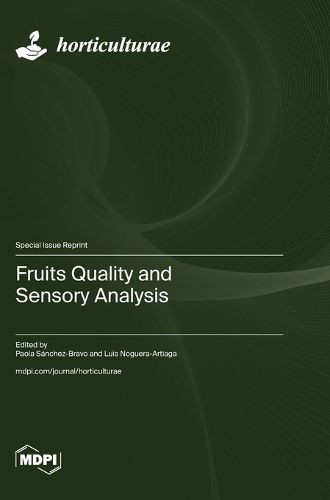Readings Newsletter
Become a Readings Member to make your shopping experience even easier.
Sign in or sign up for free!
You’re not far away from qualifying for FREE standard shipping within Australia
You’ve qualified for FREE standard shipping within Australia
The cart is loading…






This title is printed to order. This book may have been self-published. If so, we cannot guarantee the quality of the content. In the main most books will have gone through the editing process however some may not. We therefore suggest that you be aware of this before ordering this book. If in doubt check either the author or publisher’s details as we are unable to accept any returns unless they are faulty. Please contact us if you have any questions.
Fruits and vegetables are a fundamental part of the human diet and are also an important source of bioactive compounds. Today, consumers are increasingly demanding sustainable and higher-quality food; therefore, the quality of fruit has become a key factor in purchase choice, both due to the increase in health awareness among the population, who are looking for foods that promote health and sustainability, as well as the sensory qualities (visual and organoleptic) that make fruit and vegetables attractive.To reduce food quality losses and maintain the content of compounds related to health, as well as consumption by consumers, research is required to improve the quality and the parameters affected during the cultivation or processing of fruits, since, to obtain quality food products, it is necessary to control them from the moment they are planted and picked. Furthermore, preserving the integrity of bioactive ingredients during food processing is a challenge for the agri-food industry. Finally, sensory analysis in the food industry is recognized as one of the most important ways to ensure the consumer acceptance of food.This Special Issue focuses on reporting on the current state of the art; the changes undergone in the (functional, nutritional, and sensory) quality of fruits throughout their growth, processing, and shelf life; and acceptance by consumers through the sensory analysis tool.
$9.00 standard shipping within Australia
FREE standard shipping within Australia for orders over $100.00
Express & International shipping calculated at checkout
This title is printed to order. This book may have been self-published. If so, we cannot guarantee the quality of the content. In the main most books will have gone through the editing process however some may not. We therefore suggest that you be aware of this before ordering this book. If in doubt check either the author or publisher’s details as we are unable to accept any returns unless they are faulty. Please contact us if you have any questions.
Fruits and vegetables are a fundamental part of the human diet and are also an important source of bioactive compounds. Today, consumers are increasingly demanding sustainable and higher-quality food; therefore, the quality of fruit has become a key factor in purchase choice, both due to the increase in health awareness among the population, who are looking for foods that promote health and sustainability, as well as the sensory qualities (visual and organoleptic) that make fruit and vegetables attractive.To reduce food quality losses and maintain the content of compounds related to health, as well as consumption by consumers, research is required to improve the quality and the parameters affected during the cultivation or processing of fruits, since, to obtain quality food products, it is necessary to control them from the moment they are planted and picked. Furthermore, preserving the integrity of bioactive ingredients during food processing is a challenge for the agri-food industry. Finally, sensory analysis in the food industry is recognized as one of the most important ways to ensure the consumer acceptance of food.This Special Issue focuses on reporting on the current state of the art; the changes undergone in the (functional, nutritional, and sensory) quality of fruits throughout their growth, processing, and shelf life; and acceptance by consumers through the sensory analysis tool.